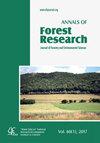两种数据收集方法的比较,以模拟收割机的生产力:手动时间研究和后续研究使用车载计算机干记录
IF 2.9
3区 农林科学
Q2 FORESTRY
引用次数: 26
摘要
采用两种数据收集方法:人工时间研究和斯坦福干文件的后续研究,对机械化帕特拉采伐作业的生产力进行了估计和建模。本研究的目的是比较使用这两种方法得出的生产率模型,以检验是否等价。对四种不同的机器及其操作员进行了人工时间研究。包括两台配备H8头的庞塞熊收割机和两台配备H6头的庞塞海狸收割机。所有机器都配备了Ponsse Opti2信息系统。所有四位操作员都有大约1年的操作各自机器的经验。这四台机器分别在四棵树宽的采伐走廊上工作,每台采伐200棵树。单株树胸径(DBH)和树高测量均由人工完成。随后,每项研究中的树木数据都是从斯坦福大学每个采集者的茎报告中提取出来的。茎报告中的周期时间是根据连续收获时间戳之间的差异确定的。比较了这两种方法估算树木胸径、体积和生产力的能力。在所有四种情况下,使用两种方法得出的胸径和体积测量结果存在显著差异。随后,从手工方法的体积测量被用作生产力计算的基础。生产率比较的结果发现,两种方法开发的模型之间没有显著差异。这些结果表明,使用任何一种方法都可以在时间方面建立等效的生产力模型,但是体积差异表明需要将树皮和体积函数与该国经历的高变异性相协调。本文章由计算机程序翻译,如有差异,请以英文原文为准。
A comparison of two methods of data collection for modelling productivity of harvesters: manual time study and follow-up study using on-board-computer stem records
Productivity of a mechanized P. patula cut-to-length harvesting operation was estimated and modelled using two methods of data collection: manual time study and follow-up study using StanForD stem files. The objective of the study was to compare the productivity models derived using these two methods to test for equivalence. Manual time studies were completed on four different machines and their operators. Two Ponsse Bear harvesters fitted with H8 heads, and two Ponsse Beaver harvesters, fitted with H6 heads, were included. All machines were equipped with Ponsse Opti2 information system. All four operators had approximately 1 year of experience working with their respective machines. The four machines worked in separate four-tree-wide harvesting corridors, and they each harvested 200 trees. Individual tree diameter at breast height (DBH), and height measurements were made manually. Subsequently, data on the trees in each study were extracted from the StanForD stem reports from each of the harvesters. Cycle times in the stem reports were determined based on the difference between consecutive harvest timestamps. The two methods were compared in terms of their abilities to estimate equivalent measures for tree DBH, volume, and productivity. In all four cases, significant differences were found between the DBH and volume measures derived using the two methods. Subsequently, the volume measures from the manual methods were used as the basis for productivity calculations. Results of the productivity comparisons found no significant differences between the models developed from the two methods. These results suggest that equivalent productivity models can be developed in terms of time using either method, however volume discrepancies indicate a need to reconcile bark and volume functions with the high variability experienced in the country.
求助全文
通过发布文献求助,成功后即可免费获取论文全文。
去求助
来源期刊

Annals of Forest Research
FORESTRY-
CiteScore
2.20
自引率
11.10%
发文量
11
审稿时长
12 weeks
期刊介绍:
Annals of Forest Research is a semestrial open access journal, which publishes research articles, research notes and critical review papers, exclusively in English, on topics dealing with forestry and environmental sciences. The journal promotes high scientific level articles, by following international editorial conventions and by applying a peer-review selection process.
 求助内容:
求助内容: 应助结果提醒方式:
应助结果提醒方式:


